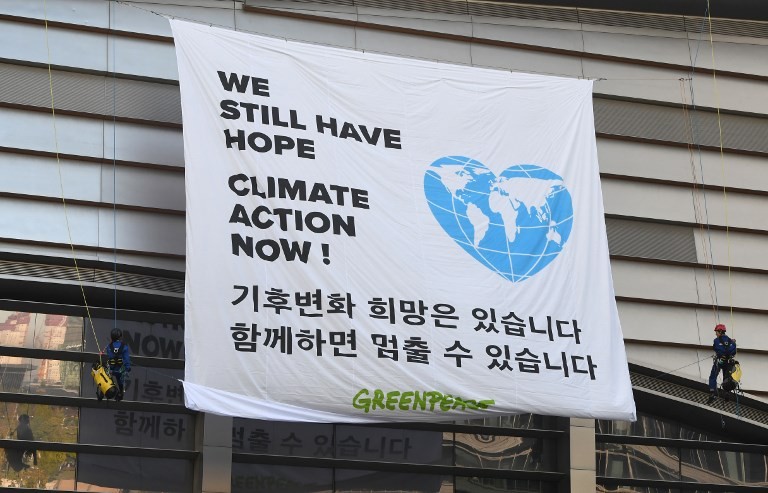Popular Reads
Top Results
Can't find what you're looking for?
View all search resultsPopular Reads
Top Results
Can't find what you're looking for?
View all search resultsKey points in the UN report on climate change
Change text size
Gift Premium Articles
to Anyone
T
he landmark UN report on limiting global warming to 1.5 degrees Celsius was released in South Korea on Monday after a week-long meeting of the 195-nation Intergovernmental Panel on Climate Change (IPCC).
A "Summary for Policymakers" of the 400-page tome underscores how quickly global warming has outstripped humanity's attempts to tame it, and outlines stark options -- all requiring a makeover of the world economy -- for avoiding the worst ravages of climate change.
Here are key findings, grounded in some 6,000 peer-reviewed scientific studies:
- 'Unprecedented changes' -
Capping global warming at 1.5C (2.7 degrees Fahrenheit) above pre-industrial levels will require "rapid, far-reaching and unprecedented changes in all aspects of society", the IPCC said.
Earth's average surface temperature has already gone up 1C -- enough to unleash a crescendo of deadly extreme weather -- and is on track to rise another two or three degrees absent a sharp and sustained reduction in carbon pollution.
At current levels of greenhouse gas emissions, we could pass the 1.5C marker as early as 2030, and no later than mid-century, the report finds with "high confidence".
To have at least a 50-50 chance of staying under 1.5C without overshooting the mark, the world must, by 2050, become "carbon neutral".
Emissions of carbon dioxide -- the main greenhouse gas -- should peak no later than 2020 and curve sharply downward from there, according to scenarios in the report.
Easier said than done: humanity dumped a record amount of CO2 into the atmosphere last year.
- The steep cost of inaction -
The 30-page executive summary also details humanity's "carbon budget" -- the amount of CO2 we can emit and still stay under the 1.5C ceiling.
For a two-thirds chance of success, that is about 420 billion tonnes, an allowance that would -- according to current trends -- be used up in a decade.
The share of electricity generated by renewables -- mainly hydro, solar and wind -- would have to jump by mid-century from about 20 to 70 percent. The share of coal, meanwhile, would need to drop from 40 percent to low single digits.
Limiting global warming to 1.5C will require investing about $2.4 trillion in the global energy system every year between 2016 and 2035, or about 2.5 percent of world GDP.
This price tag, however, must be weighed against the even steeper cost of inaction, the report says.
Read also: UN report on 'mission impossible' climate target: Key points
- 1.5C vs. 2C -
Two degrees Celsius was long considered the temperature guardrail for a climate-safe world, but a raft of recent research shows otherwise.
"Climate impacts are exponentially more dramatic when we go from 1.5C to 2C," said Henri Waisman, a scientist at the Institute for Sustainable Development and International Relations, and a coordinating lead author of the IPCC report.
What used to be once-a-century heatwaves in the northern hemisphere, for example, will become 50 percent more likely in many regions with an extra half-degree of warming.
Some tropical fisheries are likely to collapse somewhere between the 1.5C and 2C benchmark. Staple food crops will decline in yield and nutritional value by an extra 10 to 15 percent. Coral reefs will mostly perish. The rate of species loss will accelerate "substantially".
Most worrying of all, perhaps, are temperature thresholds between 1.5C and 2C that could push Arctic sea ice, methane-laden permafrost, and melting polar ice sheets with enough frozen water to lift oceans by a dozen meters, past a point of no return.
- Pathways -
IPCC authors say the 1.5C goal is technically and economically feasible, but depends on political leadership to become reality.
The report lays out four 1.5C scenarios that shadow current and future policy debates on the best way to ramp up the fight against climate change.
One pathway, for example, relies heavily on a deep reduction in energy demand, while another assumes major changes in consumption habits, such as eating less meat and abandoning cars with internal combustion engines.
Two others depend on sucking massive amounts of CO2 out of the air, either though large-scale reforestation, use of biofuels, or direct carbon capture.











